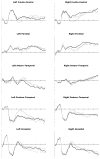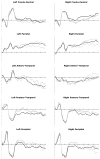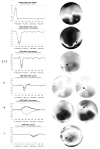ERP measures of partial semantic knowledge: left temporal indices of skill differences and lexical quality
- PMID: 18565637
- PMCID: PMC3293183
- DOI: 10.1016/j.biopsycho.2008.04.017
ERP measures of partial semantic knowledge: left temporal indices of skill differences and lexical quality
Abstract
This study examines the sensitivity of early event-related potentials (ERPs) to degrees of word semantic knowledge. Participants with strong, average, or weak vocabulary skills made speeded lexical decisions to letter strings. To represent the full spectrum of word knowledge among adult native-English speakers, we used rare words that were orthographically matched with more familiar words and with pseudowords. Since the lexical decision could not reliably be made on the basis of word form, subjects were obliged to use semantic knowledge to perform the task. A d' analysis suggested that high-skilled subjects adopted a more conservative strategy in response to rare versus more familiar words. Moreover, the high-skilled participants showed a trend towards an enhanced "N2c" to rare words, and a similar posterior temporal effect reached significance approximately 650 ms. Generators for these effects were localized to left temporal cortex. We discuss implications of these results for word learning and for theories of lexical semantic access.
Figures









Similar articles
-
Lexical quality in the brain: ERP evidence for robust word learning from context.Dev Neuropsychol. 2010;35(4):376-403. doi: 10.1080/87565641.2010.480915. Dev Neuropsychol. 2010. PMID: 20614356 Free PMC article.
-
The time course of visual word recognition as revealed by linear regression analysis of ERP data.Neuroimage. 2006 May 1;30(4):1383-400. doi: 10.1016/j.neuroimage.2005.11.048. Epub 2006 Feb 7. Neuroimage. 2006. PMID: 16460964
-
Hemispheric differences in strong versus weak semantic priming: evidence from event-related brain potentials.Brain Lang. 2007 Jan;100(1):23-43. doi: 10.1016/j.bandl.2006.06.117. Epub 2006 Sep 5. Brain Lang. 2007. PMID: 16908058
-
ERP manifestations of processing printed words at different psycholinguistic levels: time course and scalp distribution.J Cogn Neurosci. 1999 May;11(3):235-60. doi: 10.1162/089892999563373. J Cogn Neurosci. 1999. PMID: 10402254
-
An ERP study of category priming: evidence of early lexical semantic access.Biol Psychol. 2009 Jan;80(1):122-9. doi: 10.1016/j.biopsycho.2008.04.009. Epub 2008 Apr 29. Biol Psychol. 2009. PMID: 18524454
Cited by
-
Lexical quality in the brain: ERP evidence for robust word learning from context.Dev Neuropsychol. 2010;35(4):376-403. doi: 10.1080/87565641.2010.480915. Dev Neuropsychol. 2010. PMID: 20614356 Free PMC article.
-
Effects of induced orthographic and semantic knowledge on subsequent learning: A test of the partial knowledge hypothesis.Read Writ. 2016 Mar;29(3):475-500. doi: 10.1007/s11145-015-9612-x. Epub 2016 Jan 13. Read Writ. 2016. PMID: 27777496 Free PMC article.
-
Attention in children with obstructive sleep apnoea: an event-related potentials study.Sleep Med. 2012 Apr;13(4):368-77. doi: 10.1016/j.sleep.2011.06.007. Epub 2012 Mar 15. Sleep Med. 2012. PMID: 22425681 Free PMC article. Clinical Trial.
-
Looking and touching: what extant approaches reveal about the structure of early word knowledge.Dev Sci. 2015 Sep;18(5):723-35. doi: 10.1111/desc.12250. Epub 2014 Nov 28. Dev Sci. 2015. PMID: 25444711 Free PMC article.
-
Predicting Robust Vocabulary Growth from Measures of Incremental Learning.Sci Stud Read. 2011 Jan 1;15(1):71-91. doi: 10.1080/10888438.2011.539076. Sci Stud Read. 2011. PMID: 21442050 Free PMC article.
References
-
- Beck I, McKeown M, Kucan L. Bringing Words to Life: Robust Vocabulary Instruction. Guilford Press; New York: 2002.
-
- Bentin S, Mouchetant-Rostaing Y, Giard MH, Echallier JF, Pernier J. ERP manifestations of processing printed words at different psycholinguistic levels: time course and scalp distribution. Journal of Cognitive Neuroscience. 1999;11 (3):235–260. - PubMed
-
- Binder JR, McKiernan KA, Parsons ME, Westbury CF, Possing ET, Kaufman JN, et al. Neural correlates of lexical access during visual word recognition. Journal of Cognitive Neuroscience. 2003;15 (3):372–393. - PubMed
-
- Brown JI, Fishko VV, Hanna G. Nelson–Denny Reading Test. Riverside Publishing Co; New York: 1993.
-
- Brown J, Frishkoff G, Eskenazi M. Automatic question generation for vocabulary assessment. Proceedings of the Annual Human Language Technology Meeting; October 6–8; Vancouver, BC. 2005.
Publication types
MeSH terms
Grants and funding
LinkOut - more resources
Full Text Sources

